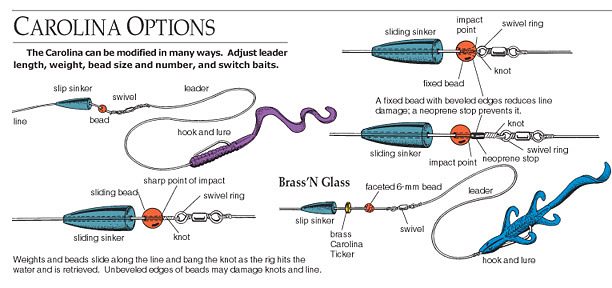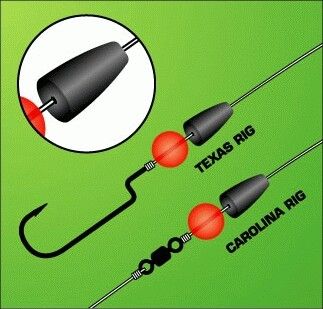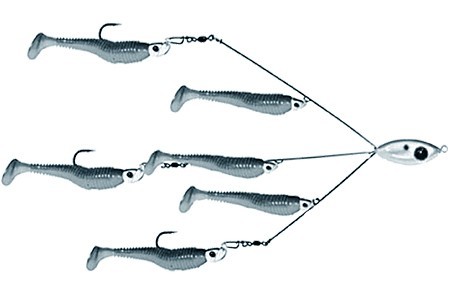
Carolina Rig
The Carolina rig is a popular rig that anglers use to make lures more appealing to bass. Often, an angler has the chance of increasing her or his luck of catching large bass. While the rig may seem complicated, it is rather simple to setup.
If you have not yet fished with the rig setup, you might be missing out on a better bass fishing experience. On the other hand, if you have never used it, you likely have no familiarity with how it works, why it works, and the best ways to use it.
Understanding everything there is to know about the Carolina setup may very well improve your ability to catch bass. Because of the way the rig works, large bass often find themselves naturally drawn to the lure. Fortunately, figuring out what the rig is all about and why you should use it is simple.
What’s the Appeal?
Carolina rig fishing is nearly identical to Texas rig fishing with a few exceptions. For instance, when it comes to the Carolina rig vs Texas rig, the Texas rig features a weight that sits snug against the lure. The Carolina, on the other hand, has a weight followed by a lure that sits on a leader line.
For either rig, anglers use a soft plastic lure. Although Texas rig fishing is great, you might find that learning how to fish a Carolina rig is just as good, if not better. Of course, Texas rigs and Carolina rigs each work wonders in different scenarios, too.
To understand what makes the rig so appealing, you need to understand the habits and behaviors of the target species your going after. For instance, bass like many other fish species, operate in two different modes when it comes to their feeding habits and behaviors:
- Opportunity Feeding: Bass typically feed opportunistically, meaning they eat whenever they are hungry and rely on a variety of food sources to sustain them.
- Aggressive Feeding: Although this mode is rare, it is the mode that anglers prefer since bass will aggressively attack anything that appears as food before their eyes.
Keep in mind that in opportunistic mode, bass are relatively lazy fish. They will not aggressively search for something to eat. Instead, they typically stay in one spot deciding if something looks tasty enough to eat.
To catch a bass in lazy, opportunistic mode, you must drop your bait right in front of the fish. The bass will then survey the bait to determine if it looks worthwhile. After a time, the fish may pick up your bait, test it to see how desirable it is, and either swallow it or quickly spit it back out.
With a properly rigged up lure like this one, you can drop your bait in just the right spot for a lazy bass. Bass are also attracted to the rig because it allows the bait to move in a circle the distance of the lead line. The motion of the lure appears attractive to fish in both aggressive feeding and opportunistic feeding modes.
Many anglers love fishing with the Carolina rig setup because it is easy enough to figure out for beginners while offering enough bass catching action for the pros. In fact, it’s the ease of setting it up and the professionalism of its use that makes it such a popular choice.
When to Use It
The rig proves effective in the spring, but many anglers also love to use it in the winter months. During the cold season, fish tend to stick to the bottom of deeper waters. The water is far colder at the surface, so bass will seek what warmth they can find in the deeper end of whatever body of water your targeting.
For that reason, you need a rig that will seek out the bottom of a body of water with ease. Because the Carolina rig has a heavy weight, fishermen can cast further into the water’s depths. The weight also allows the setup to sink to the bottom, thus enhancing your ability to catch fish.
Also, make sure you opt to use this setup on windy, cloudy days. Bass behave in a way that causes them to roam through the water more frequently on days like that. Because of their tendency to roam, you need a lure that can cover a larger area, which is something the Carolina can do.
Tips for Maximizing the Use of the Rig
Maximizing the use of your rig is not that difficult, and can improve your fishing game. There are at least a few ways you can maximize your setup.
- Buy Tungsten – When it comes to Carolina rig weights, almost nothing compares to the use of tungsten weight. Compared to lead, the metal is smaller, denser, and even harder. Although you will certainly drop more cash on tungsten weights, they are well worth the price.
- Choose Your Line – Many debates surround the fishing line you should use. While there are those who suggest using a braided fishing line, others believe that a fluorocarbon fishing line paired with a fluorocarbon leader is a great setup. The fluorocarbon line gives you the shock absorption you need to detect a fish. Monofilament is also good, but fluorocarbon sinks faster, too, which makes it a terrific option.
- Use Soft Lures – Don’t simply assume that you should use soft Carolina rig worms. Soft bodied worm lures work great, but you need other options, too. For instance, you should also purchase a soft bodied lure that mimics a crawfish. Be sure to keep your color range wide, it doesn’t hurt to have a couple of extra colors in your tackle box come fishing time.
- Mind the Length of Your Leader – Make sure you pay attention to the length of your leader. It appears that most anglers seem to do well with a leader length of approximately 15 to 18 inches.
- Choose a Longer Fishing Rod – Typically, a standard fishing pole is 7-foot long, but anglers recommend using a pool that is at least 7-foot, 6 inches in length. You will gain better line management and casting capabilities with the longer rod. Some anglers go as far as to use 9’+ flipping rods that are as thick as the diameter of your thumb at the tip. Flipping the Carolina Rig into a weed bed and then snatching the fish out before they know the hook is set, is a surefire way to land bass.
By maximizing the use of your rig, you are increasing your likelihood of catching more bass. Make sure to follow all the tips listed so you can gain the most enjoyment out of your rig setup.
Carolina Rig vs. Texas Rig

Carolina Rig Vs Texas Rig
The differences between the Carolina rig and the Texas rig mentioned above can help you determine when you should use each one. There are situations where you will find it is better to use a Texas setup compared to the Carolina setup, and vice versa.
Typically, the Carolina should be your go-to setup if you need to cover a larger area of water to find fish. Because of the way the setup works, it also serves as a temptation for fish, no matter if they are feeling aggressive or lazy.
The Texas rig, on the other hand, works better if you are targeting fish that like to hide in thick cover. You should also use a Texas rig when trying to catch fish off steep drops. Unfortunately, the Carolina tends to snag through thick cover and from drops.
The Texas setup can also make its way down into smaller holes, globs of seaweed, underwater brush, and more. Keep in mind that the Carolina rig seems to move more rapidly compared to the Texas rig. With a Texas fishing rig, you can offer subtle movements of your bait through the water, thus changing how fish react.
What About the Alabama Rig?

Alabama Rig
The Alabama rig is nothing like the Carolina or even the Texas rig. Rather than having one lure, the Alabama rig has five lures. The rig consists of five wires that you must angle out from one another, so they look like umbrella spokes.
When you hang the five lures from each of the wires, it looks like a small school of fish swimming in the water. The Alabama rig most frequently catches the eye of larger fish, such as walleye. Although it would also capture the attention of bass, it may not be acceptable for use in tournaments.
Many competitions ban the use of the Alabama Rig, such as F.L.W Outdoors and BASS. Everything from college tournaments to amateur series events upheld the ban against the rig. In truth, the rig is a wonderful setup for fishing, but like everything else it has it’s drawbacks.
Carolina Rig Fishing Compared to Drop Shot Fishing
Drop shotting is yet another popular method used to catch bass. However, it is interesting to note that the person who invented drop shotting was a salt water fishermen. The technique works wonders throughout several bodies of water, particularly salt water lakes and the like.

Drop Shot Rig
When compared to the Carolina rig, the drop shot is rather valuable to bass fishermen, but each offers their own pros and cons. The Carolina still seems to work best in deep waters. It is also the optimal choice for fishermen looking to catch bass during the spring season. Of course, if you plan on fishing in saltwater, you might opt for the drop shot rig instead.
If you are interested in the drop shot, you might be wondering, “How do you rig a drop shot?” Just like the Carolina, rigging up the drop shot is also easy. You will need to:
- Place the tag end of your line through your drop shot hook – length of line pulled through the hook should be around 10-12 inches
- Now take the tag end and push it through the opposite end of the line tie – you know you have done this step correct if you have a loop on one side of your drop shot hook
- With the two strands of line and the loop you formed, tie an overhand knot – but make sure not to pull it tight yet
- Bring the loop that you made over the knot and hook
- Wet the knot and then pull it tight
- Take your tag end once again and push it through the top of the line tie
- Now use the tag end to place your weight on the line
- Attach your lure to your hook – since drop hooks are small, opt for a nose hook through your lure
Setting Up the Rig
If you do not know how to rig a Carolina rig, fear not. Understanding how to set it up is quick and easy. To begin with, you will need:
- A Fishing Rod – Preferably 7-foot, 6 inches or longer, medium heavy
- Beads – You can use glass or plastic, but most anglers prefer plastic (beads protect knot from the weight sliding up and down and create a noisemaker)
- Swivel – Use an appropriate swivel based on your tackle size, or opt to use a Carolina Keeper instead, which requires less knot tying and untying, and easily allows you to adjust your lead length
- Hooks – Use the appropriate hook based on your bait or lure
- Leader line – You can opt for monofilament, braided, of fluorocarbon line, but most anglers prefer fluorocarbon
- Reel – The baitcasting reel is the most preferred reel, especially one with a 6:1 gear ratio so you can bring your line in quickly when needed
- Singers or Weights – You have your choice of barrel sinkers or bullet head sinkers, and although lead sinkers are common, consider paying extra for tungsten weights instead
To figure out how to tie a Carolina rig, you will first need to do the following:
- Start by threading your fishing line through your sinker or weight and do not tie a knot just yet (tip: beads and swivels work with bullet head sinkers best)
- Thread your line through your plastic or glass bead and slide it up to the sinker
- Tie your swivel to your fishing line
The three components you just placed on your fishing line are what create the Carolina rig. Of course, you will need to continue setting up your lead, hooks, and lures. You can choose whatever leader length best suits you. Some anglers use an 18-inch leader length while others use less or more.
It is up to you what lure you use, too. You can opt for a soft bodied crawfish or a soft bodied worm. The hook you use will depend on your lure. Keep in mind that there is no one-size-fits-all Carolina rig hook. Instead, you should make sure you have different hooks with you in case you decide to swap out your lures.
If you are still having trouble with your rig setup, this video tutorial may help you out. The only variations you might find is that some people prefer to use a Carolina Keeper rather than a swivel. Rather than tying and untying knots, you simply squeeze the keeper and adjust your lead length.
You will also find that some fishers will use standard lead sinkers and others will use tungsten weights. Although you can easily use either, it is recommended that you spend the extra money purchasing a tungsten weight if you can.
You will also notice variations in the type of lures anglers use and the leader length they prefer. Otherwise, you will find that the video adequately highlights how to put together a solid rig for your next bass fishing adventure.
Part of what makes the setup of the rig so fantastic is that you can do it in under two minutes. Anglers looking to catch fish do not want to waste time with too many knots or a ridiculously lengthy setup. Thankfully, the Carolina rig is both fast and simple.
How to Use the Rig
Simply casting your rig into the water and waiting is not always an option. Of course, if you catch bass when they are in aggressive feeding mode, they may snatch up the lure rather quickly. If you do not notice a quick hit, you may have to make the bait look a little more enticing.
Of course, even when fish are in the opportunistic mode, it still may take them a bit to react to the presence of your bait. The slower you move your bait across the bottom of the water, the more appealing it looks to bass fish. Instead of using the reel, you will use the rod to move the bait.
Hold your rod so that it is parallel to the water in the direction you cast your rig. Imagine that the rig is sitting in the 12 o’clock position and move your rod from the 12 to the 2 o’clock position and back again. Do this repeatedly, but not too quickly.
Moving the rod back and forth in that motion moves the bait across the bottom slowly so that it offers a slow jig or dance across the bottom. That come-hither dance appeals to bass and calls them over to test your rig.
Have You Caught One?
Make sure you pay attention to the hit sensation on your line. As mentioned earlier, bass test food by pushing it, running past it, or head butting it. You may feel a slight hit from these movements, but it is not the kind of hit you want or need to hook a fish.
However, if the hit feels different to you, or if you aren’t sure what type of hit sensation you experienced, go ahead and set your hook. It is better to play it safe rather than sorry. If you miss your fish, you can always recast and try again.
Aside from hit sensation, you can also pay attention to line movement. Line movement may indicate that a bass has picked up your lure. Sometimes a bass will pick up your lure and move somewhere with it. They do this so they can hide from other fish while they test the quality of your food offering.
Keep in mind that if the offering is not appealing, they will spit it out, and quick! Make sure to react just as quickly. The goal is to set the hook long before the bass ever has a chance of spitting it out. Keep in mind that with the Carolina setup, a bass might react to your lure much faster than a standard lure.
The fast reaction of the bass might leave you stunned, which can slow your reaction time. As long as you keep your head focused and know what you might be able to expect, you may just have a chance at experiencing a phenomenal bass fishing adventure.
Just for Bass Fishing?
The Carolina rig is not just for bass fishing, of course, but it is highly attractive to bass. You can swap out the bait to attract nearly any species of fish that prefers to feed on the bottom. It can be used to successfully land flounder in saltwater for instance. The setup purposely keeps your bait at the bottom, thus attracting whatever might see it there.
For that reason, many anglers use Carolina rigs for catfishing. Simply swap out your lure for something attractive to catfish, such as liver, worms, or another specified catfish bait. Catfish tend to scavenge for their food at the bottom of rivers, lakes, and strip pits, and since the rig keeps your bait at the bottom, it is a great setup.
Carolina Rig Restrictions
When it comes to fishing, the Carolina rigs bass love are why anglers use them so much. However, they do have their restrictions. Restrictions of this rig include:
- Thick Vegetation: If you are fishing in an area known to have thick vegetation, you might want to avoid using your Carolina setup since it tends to snag and tangle
- Dense Brush Coverage: If you see dense brush coverage throughout your fishing spot, opt for something other than the Carolina to avoid unnecessary snags
- Rocky Bottom: If you know that there are large rocks, or boulders, situated close together at the bottom of the water, you will want to avoid using your rig so that it does not get caught up trying to move through the rocks
Aside from those few scenarios, the Carolina is a rather adaptable setup that you can use almost anywhere. Now that you know just about everything you could know about the Carolina rig, you should get out there and see what it can do for you and your bass fishing game.
